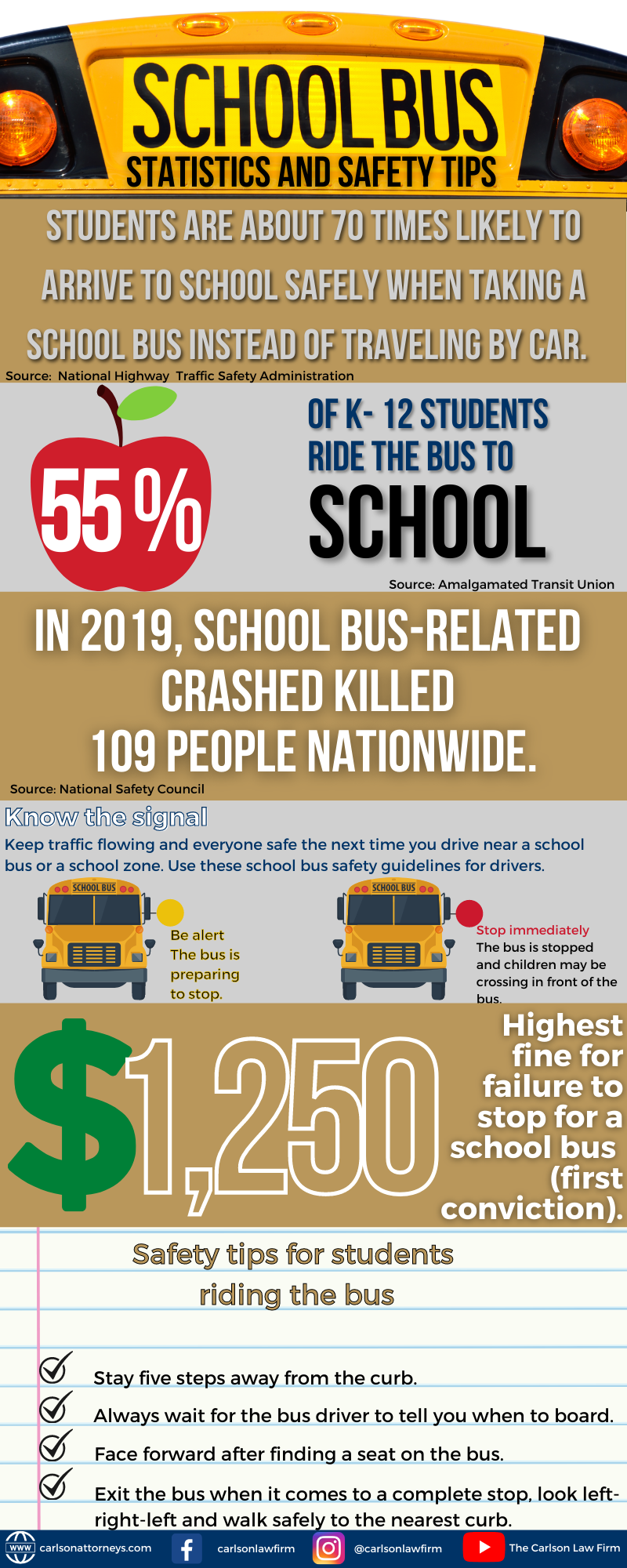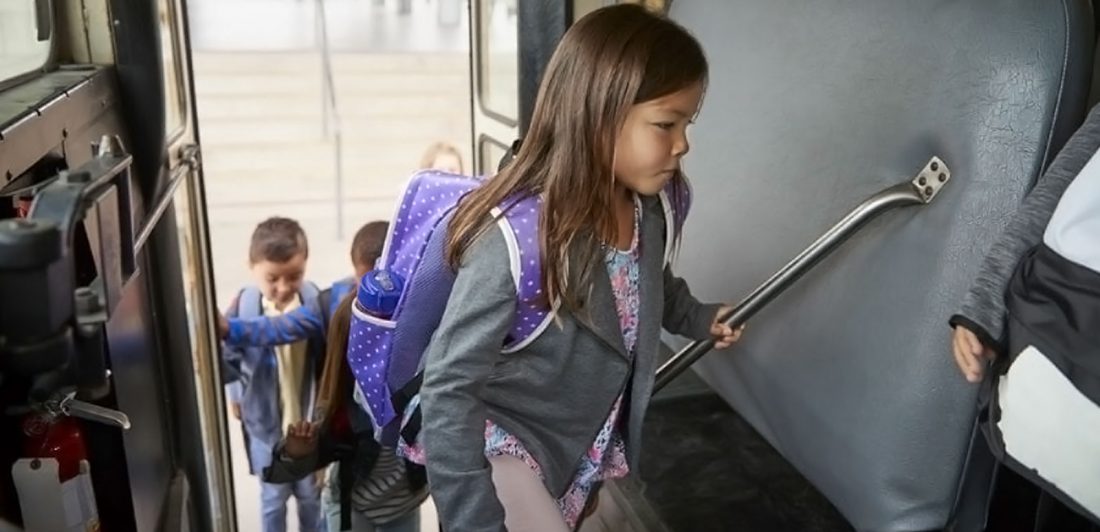Children all over the country are heading back to school. Some students will be walking to school, and others will catch a ride from mom, dad, or grandma. But nearly 25 million U.S. students will take the bus to school. Luckily, school buses are one of the safest modes of transportation on the roadways. In fact, the National Highway Traffic Safety Administration (NHTSA) says that students are almost 70 times more likely to get to school safely when taking the bus instead of traveling by car.
However, it’s still important to recognize that children face several dangers on and off the school bus.
Loading and Unloading
The biggest danger a child encounters while riding the bus is not the ride itself, but rather getting on and off the bus safely. Most children injured or killed in school transportation accidents were on foot, not the bus, at the time.
Children are most in danger when they are pedestrians walking to or from the school bus. Nearly 20% of school bus drivers have reported that vehicles passed their buses illegally. When a motorist disregards the control arm, they are putting children in danger.
School Transportation Crashes Can Happen
School buses are the safest form of transportation for school-aged children. In fact, NHTSA reports that of all motor vehicle crashes, school transportation incidents make up only 0.4% of all traffic incidents.
The majority of these school bus accidents happen in the early morning and during school drop-off times, when children are at their bus stop. Unfortunately, there is an average of 110 school transportation fatalities yearly; however, many of the fatalities reported did not involve school-aged children and occurred in rural areas.
- 5% of fatalities were school bus drivers.
- 5% of fatalities were school bus passengers.
- 20% of the fatalities were pedestrians, including bicyclists.
- 70% of the fatalities were occupants of other vehicles involved.
The Danger Zone
There is a danger zone around the outside of every school bus where children are at the most risk of being hit, either by the bus itself or another vehicle. This danger zone extends as far as 30 feet from the front bumper, 10 feet from the left and right sides, and 10 feet behind the rear bumper.
This area is so dangerous because it is extremely hard for the driver to see. If a student drops something in this area they should never try to retrieve it on their own; they must alert the driver.
School Bus Safety Tips
Staying educated on school bus safety is equally as important for children as it is for those that drive past school bus stops and school zones. Some school bus safety tips include:
Drivers:
- Drive with caution, especially in neighborhoods that have school zones.
- Obey the school bus laws in your state as well as the “flashing signal light system” that bus drivers use to alert motorists of their pending actions.
- Be careful backing out of driveways, and be mindful of children walking.
Students at the bus stop:
- Stay at least five large steps away from the bus as it approaches the bus stop.
- Do not cross the street until the bus has come to a complete stop, the control arm is activated, the driver signals them on, and the student looks both ways.
- Never walk close to the sides of the buses.
- Do not talk to strangers.
- Never bend down to reach an item that has fallen in the danger zone without alerting the bus driver.
- Do not have strings hanging from jackets or backpacks, as they can get stuck in the door of the bus.
Students on the bus:
- Stay seated while the bus is moving.
- If there are seat belts, make sure they are fastened correctly.
- Never put your head or limbs out of the window.
- Do not play with the emergency exits.
- Do not block the aisle. If there is an emergency a blocked aisle can increase the danger.
Bullying on the Bus
Sadly, children may face a different type of safety concern once aboard the bus: bullying. Bullying can occur anywhere, including on the school bus. Bullying can be especially harmful on the bus because the child isn’t capable of leaving the situation.
Additionally, bullies may pick the bus as the location to target other students because there is usually only one supervising authority – the bus driver. The bus driver may have a hard time spotting bullying because they are paying attention to the road.
Having a better understanding of school bus bullying can help prevent harm to students. Signs bullying is occurring on your child’s bus include the following:
- Fear of either going to school or riding the bus.
- Trying to miss the bus.
- Returning from school with ripped clothing or lost/stolen items.
- Panic attacks on school days before riding the bus.
Reacting to Bullying on the Bus
Bullying is a concern for many children, considering it affects about 27% of all school-aged children. However, there are some actions children can take to lessen the effects of bullying.
- If possible, sit close to the bus driver so they are more visible to the driver
- Switch seats to be further away from the bully
- Pair up with a neighborhood friend to ride the bus together
- Tell adults when bullying occurs
Parents should not hesitate to contact their student’s school if their child is being bullied. Schools are responsible for providing a safe learning environment for their students.
Texas School Bus Law
Numerous children and teens rely on school transportation to commute to their schools. It is important for others to follow state laws to help ensure the safety of students. Failure to follow laws can result in criminal charges. There are a few things to keep in mind while driving during the school year, including what kind of road you are traveling on.
- Two-lane roads: Vehicles traveling in both directions must stop.
- Multi-Lane Paved Across: Most commonly, four-lane roads with a median turning lane. All traffic must stop.
- Divided highways, roadways that are divided by a physical barrier. Motorists that are traveling in the same direction as the bus must stop. Vehicles that are traveling in the opposite directions are allowed to proceed with caution, looking out for student pedestrians.
How The Carlson Law Firm Can Help
If your child has been injured by a school bus or another motor vehicle, you can contact a caring and compassionate legal team at The Carlson Law Firm for a free consultation to discuss your case. We will go over the circumstances of the accident and explain your legal options. Our team of attorneys, legal assistants, nurses, and private investigators are ready to assist. We care. We can help.





